Waning Luna Passes Pretty Planets in Morning, Vesta Visits Mars, and Walking the Dog!

This north-up image of the Little Beehive Cluster, Messier 41 in Canis Major, shows the hot blue and cooler golden stars. It covers a thumb’s width of sky, measuring top to bottom. The green circle represents the field of view in a telescope at low magnification, 1.5 degrees.
Hello, Winter Astronomers!
Here are your Astronomy Skylights for the week of February 20th, 2022 by Chris Vaughan. Feel free to pass this along to your friends and send me your comments, questions, and suggested topics. You can also follow me on Twitter as @astrogeoguy! Unless otherwise noted, all times are expressed in Eastern Time. To subscribe to these emails please click this MailChimp link.
If you’d like me to bring my Digital Starlab portable inflatable planetarium to your school or other daytime or evening event, or deliver a session online, contact me through AstroGeo.ca, and we’ll tour the Universe, or the Earth’s interior, together! My terrific new book with John A. Read entitled 110 Things to See With a Telescope is a guide to viewing the deep sky objects in the Messier List – for both beginners and seasoned astronomers. DM me to order a signed copy!
The moon will spend this week waning in phase in the post-midnight sky and lingering into the morning daylight. Towards the end of the week, the crescent moon will pass close to the bright morning planets Venus and Mars. Only Uranus remains in the western evening sky, accompanied by telescope-comet 19P/Borrelly. The moonless evenings will be perfect for viewing the sights in the Big Dog, Canis Major. Read on for your Skylights!
Evening Zodiacal Light
If you live in a location where the sky is free of light pollution, you might be able to spot the Zodiacal Light, which will appear during the two weeks that precede the new moon on March 2. After the evening twilight has disappeared, you’ll have about half an hour to check the western sky for a broad wedge of faint light extending upwards from the horizon and centered on the ecliptic. That glow is the zodiacal light – sunlight scattered from countless small particles of material that populate the plane of our solar system. Don’t confuse it with the brighter Milky Way, which extends upwards from the northwestern evening horizon at this time of year.
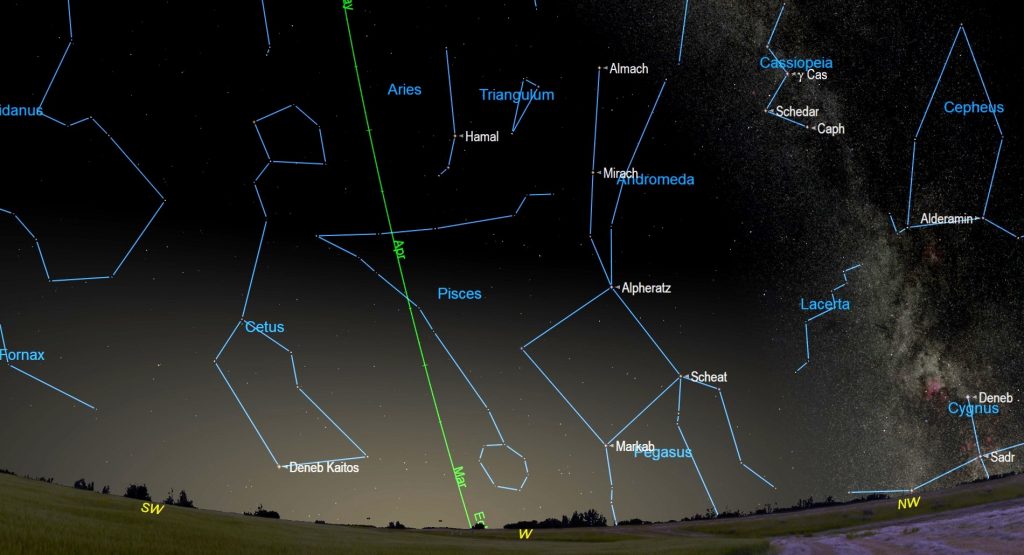
The Moon
The moon will shine on night owls this week as it wanes through third quarter. Tonight (Sunday) our natural night-light will rise after 10:30 pm local time. Its 78%-illuminated gibbous phase will be surrounded by the stars of Virgo (the Maiden) until dawn hides them, then the moon will linger for a few hours in the southwestern daytime sky. That pattern will continue all week, though the moon will rise later and linger longer as it wanes.
On Tuesday morning, February 22, observers with binoculars and backyard telescopes in much of Mexico, the USA, and western Canada can watch the moon pass in front of (or occult) the bright double star designated Alpha1,2 Librae, or Zubenelgenubi I and II in Libra (the Scales). Surrounding regions will see the moon pass very close to those two stars, which are always separated by about 1/10 of the moon’s diameter. The start and end times for the event vary by location. Use an astronomy app like Stellarium, SkySafari, or Starwalk to look up the times for your site. In Dallas, Texas, the bright leading edge of the moon will cover the first star at 5:25 am CST or 11:25 Greenwich Mean Time, and the second star will disappear 8 minutes later. Alpha1 Librae will emerge from behind the dark limb of the moon at 6:33 am CST or 12:33 GMT, followed by its partner at 6:44 am CST or 12:44 GMT. For best results, start watching several minutes ahead of each of the predicted times.
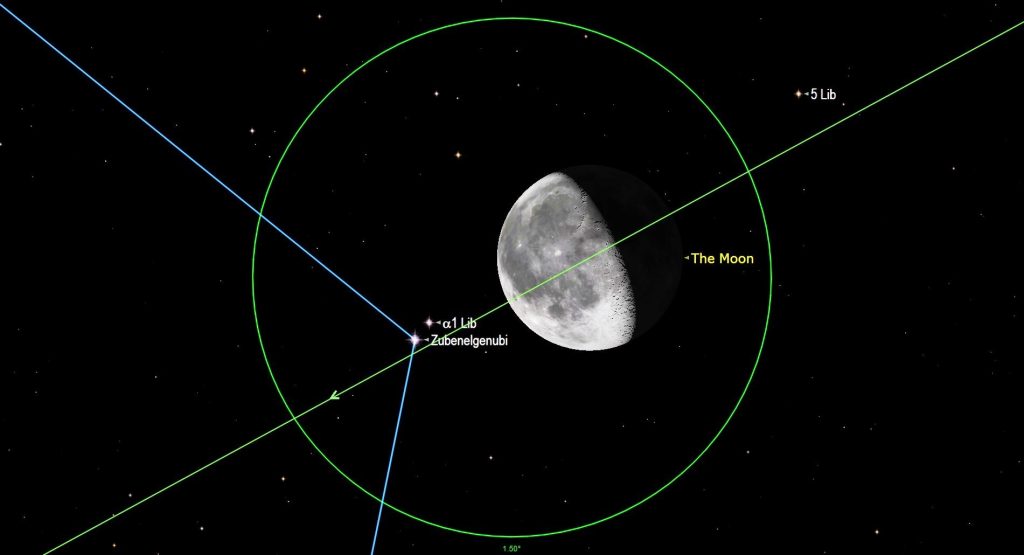
On Wednesday morning, the moon will appear slightly more than half-illuminated while it shines a few finger widths to the right (celestial west) of the three white claw stars of Scorpius (the Scorpion). The creature has been de-clawed, though. Those three stars, named Acrab, Dscubba, and Fang (or Beta, Delta, and Pi Scorpii, from to bottom) are actually his wrists. The stars for his outstretched claws are now part of Libra!
The moon will officially reach its third quarter phase – and appear exactly half illuminated on the western, sunward side – at 5:32 pm EST, 2:32 pm PST or 22:32 GMT on Wednesday. Moon phases occur independently of Earth’s rotation. While everyone on Earth sees the same phase of the moon, the moon is only above the horizon for about half of the world at any given time. In this case, early risers in Asia will see the third quarter moon in a dark sky.
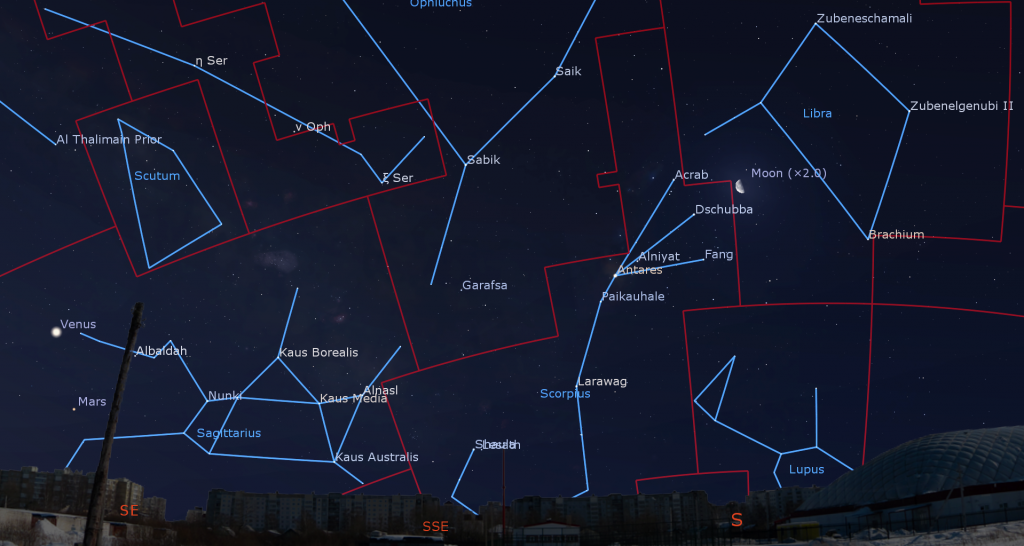
On Thursday morning, the then-crescent moon will shine a few finger widths to the upper left (celestial northeast) of the heart of the scorpion, the very bright, reddish star Antares. From about 6 am onwards, watch for the bright beacon of Venus and fainter, reddish Mars below it shining off to the moon’s left (celestial east), in Sagittarius (the Archer). The moon will hop closer to them on Friday and Saturday morning. On Sunday morning, February 27, the thin, old, crescent moon will form a neat line with extremely bright Venus at the top and Mars in the centre, making a terrific photo opportunity when composed with some interesting landscape. The fist-wide arrangement won’t allow all three objects to share the view in binoculars, but Venus and Mars or Mars and the moon, will fit. Even after magnitude 1.26 Mars fades into the brightening sky, the moon and magnitude -4.75 Venus will remain visible, until almost sunrise.
The Planets
The pre-dawn planet party is well and truly underway – and it will be a lengthy one!
To enjoy the show, you’ll need clear skies toward the southeast and an unobstructed view in that direction. Venus will be rising first, at about 4:40 am local time this week. The extremely bright planet will blaze away in the lower part of the sky almost until sunrise. Long before that, the 250 times fainter dot of reddish Mars will appear, shining less than a palm’s width below (or 5° to the celestial south) of Venus. After Mars rises at about 5 am local time, it will be visible until the brightening sky hides it about an hour later. In a telescope Venus will exhibit a 35%-illuminated, waxing crescent phase. Good binoculars will also reveal its shape. (Be sure to turn all optics away from the eastern horizon before the sun rises.)
Mars will remain perched below Venus for the next several weeks. Both planets will be travelling eastward, on gradually converging, parallel tracks. At the same time they will be slowly increasing their angle from the sun, and rising earlier. The minor planet designated (4) Vesta is travelling with them. At magnitude 7.6, it’s visible in binoculars and backyard telescopes. Early in this week, Vesta will sit a stout thumb’s widths to Mars’ upper left. Vesta is farther from the sun and therefore moves more slowly – allowing the two planets to overtake it. On the coming weekend, Vesta will pass between Venus and Mars, sitting closer to the latter.
Mercury will be leaving the party early – but it will return in June. This week, the speedy planet will be sinking sunward each morning – but you might glimpse it sitting very low above the east-southeastern horizon around 6:30 am local time. It’s actually several times brighter than Mars, but its light will be diminished by the thick atmosphere we’re looking through that low in the sky. Observers located in the tropics will see Mercury rather easily – and the yellowish dot of Saturn to its east.
The only planet remaining in the evening sky is Uranus. The magnitude +5.8 planet will be available for viewing once the sky fully darkens, at around 7:30 pm local time. It can be seen easily in binoculars and backyard telescopes – and even with your unaided eyes on dark, clear nights – if you know where to look. The planet’s small, blue-green dot will be positioned a fist’s width to the left of (or 11 degrees to the celestial southeast of) Aries’ brightest stars, Hamal and Sheratan. In fact, it’s almost exactly midway along a line connecting Hamal with the bright star Menkar in Cetus (the Whale). At 7:30 pm local time, Uranus will sit halfway up the west-southwestern sky. By 9 pm local time, it’ll be too low for decent views.
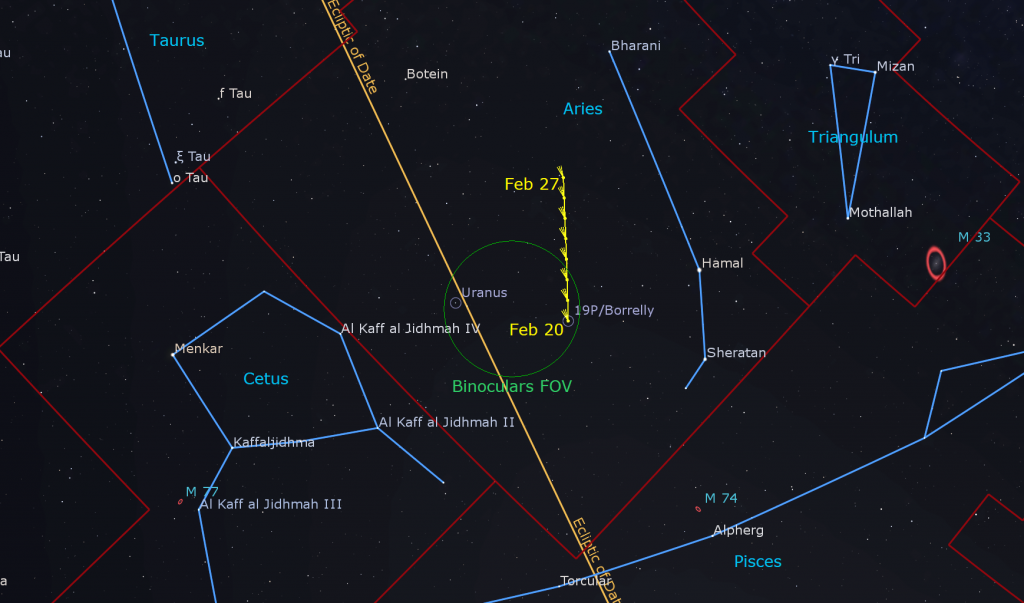
In a telescope, watch for the star named 29 Arietis shining close to Uranus, on the planet’s lower right (celestial northwest) side. It will shine as bright – but will appear a warm white colour. Comet 19P/Borrelly will be passing binoculars-close to Uranus this week, too. At magnitude 9.6, the comet should be visible as a small fuzzy patch in backyard telescopes away from city lights. It will travel between Uranus and the bright stars of Aries, and shifting higher compared to them each night.
Walking the Big Dog
The night sky’s brightest star Sirius is sure to catch your eye in the evening sky this time of the year. Once the sky darkens after 7:30 pm local time, Sirius will be sitting less than a third of the way up the southeastern sky, to the lower left of Orion (the Hunter). Sirius will reach its highest position over the southern horizon at 9 pm and then descend into the southwestern sky and set by 2 am local time.
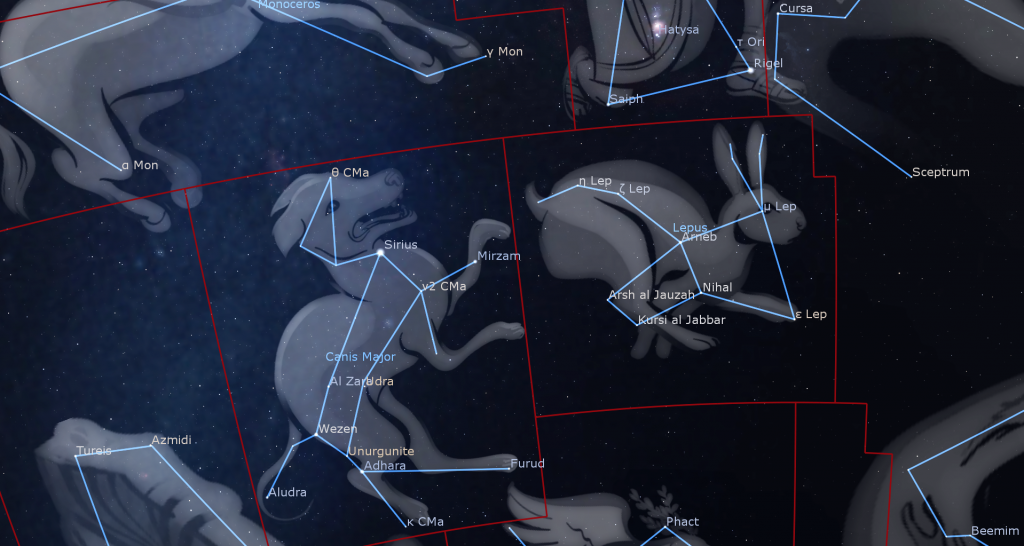
Sirius’ name means “searing” or “scorching” in Greek. It’s also commonly known as the Dog Star and Alpha Canis Majoris (α CMa) because it is the brightest star in the constellation Canis Major (the Big Dog). To my eyes, the constellation genuinely resembles a wiener dog, with Sirius sparkling as the dog’s collar! The pup’s head is formed by a triangle of medium-bright stars to Sirius’ upper left (celestial east), but those are near the limit of visibility in urban skies. Nose to tail, the constellation covers about 19°, or two fist diameters. From ears to paws, he spans about one fist diameter. The rest of the dog’s body, composed of more easily visible stars, extends to the lower left (southeast) of Sirius. Rover is rearing up and facing west, as if he is begging Orion for a treat.
About a fist’s diameter below Sirius shines the bright star Wezen (δ CMa), which marks the dog’s “bottom”. Wezen, from the Arabic phrase Al Wazn “weight” is a rare, massive, yellow supergiant star. One day it will explode in a supernova. The tip of the dog’s tail, marked by a modest star named Aludra (η CMa), is found 4° (four finger widths) to the lower left of Wezen. Two finger widths above Wezen you’ll find two less conspicuous stars positioned side-by-side and separated by two finger widths. They nicely demark the dog’s slim torso. The left-hand (celestial east) star is whitish Al Zara. To the right is fainter and orange-tinted star Udra. Both stars are designated Omicron Canis Majoris (o CMa). Al Zara is Omicron2 CMa. This modest point of light, 2760 light-years away from Earth, is a massive supergiant star – one of the most luminous stars known. It radiates about 220,000 times as much visible light as the sun. Since 1943, the spectrum of Al Zara has served as one of the reference points from which other stars are classified. Udra or Omicron1 CMa is also a supergiant that has inflated and cooled. It’s about 3500 light-years away.
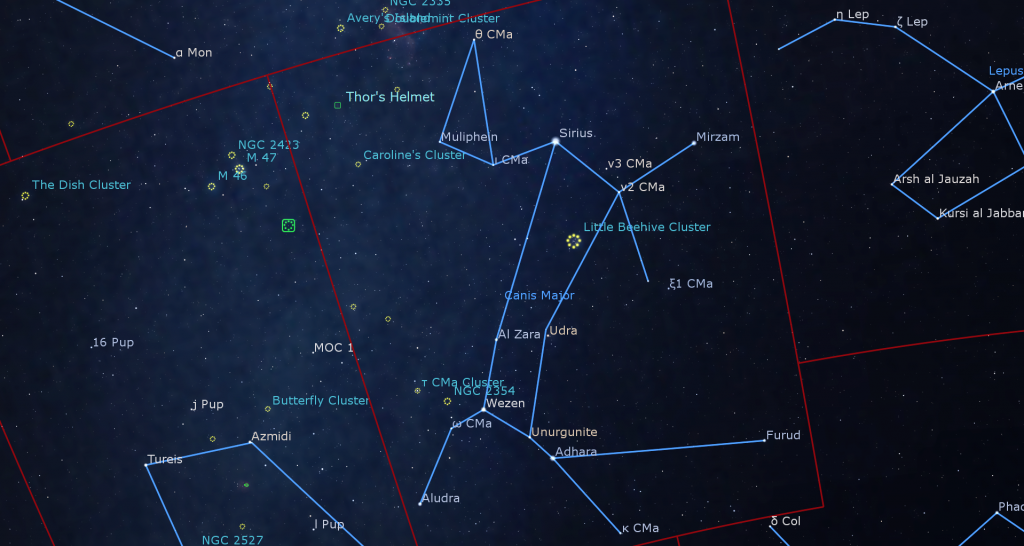
Four degrees to the lower right of Wezen, a bright star named Adhara (ε CMa) represents the dog’s rear legs. (Some representations include two dimmer stars for the rear paws.) Adhara is a hot blue giant star with a surface temperature of a whopping 21,000 K and located about 34 light-years from the sun. It’s the brightest star in the sky when viewed in ultraviolet light, and it, too, is on the way to death by supernova. Arabic astronomers associated the stars Adhara, Aludra, Wezen, and Al Zara with the Maidens in one of their stories.
The dog’s front legs are formed by the bright star Mirzam (β CMa), which is located about a palm’s width to the lower right of Sirius. Mirzam, which means “the Herald” because it rises just before Sirius, is 60 times more luminous than Sirius. If that star were located where Sirius is, instead of 500 light-years away from us, it would appear 15 times brighter than Venus!

In the heart of Canis Major, about four finger widths below Sirius, is a bright little cluster of stars designated Messier 41, sometimes called the Little Beehive Cluster. Binoculars should show it easily. The cluster, which is about 2300 light-years away from us, consists of several brighter golden stars and numerous fainter ones. Another nice cluster named NGC 2354 sits about 2.5 finger widths to the upper left of Wezen. An even nicer, but smaller cluster sits three finger widths to the left (celestial east) of Wezen. It’s formally known as the Tau CMa Cluster and NGC 2362, and also the Mexican Jumping Star and Pirate’s Jewels Cluster. In a telescope, it reminded me of a glittering Eiffel Tower!
A bright little nebula with an unusual shape is located almost a fist’s diameter to the upper left (or 8.8 degrees to the celestial northeast of Sirius. NGC 2359 is aglow with a mixture of reddish light from ionized hydrogen and some blue light scattered by interstellar dust. “Wings” of gas flanking the main zone have given it the nick-names Thor’s Helmet, the Duck Nebula, and the Flying eye Nebula. Scan around that area of sky with your binoculars – the winter Milky Way has populated Canis Major with many such dog treats.
Canis Major is only one of Orion’s two hunting companions. The other, Canis Minor (the Smaller Dog), sits 30° (or three fist diameters) to Orion’s left (east). Canis Minor is composed of only two stars – very bright white Procyon (α CMi) and dimmer Gomeisa (β CMi), which sits about four finger widths to Procyon’s upper right. Ironically, the constellation resembles the dog’s bone more than the dog! The two dogs might well be hunting Lepus (the Rabbit), a constellation of modest stars located directly below (south of) Orion.

Sirius is so bright because it is about 25 times more luminous than our Sun, and is only a mere 8.6 light-years away from Earth. Furthermore, it is heading towards us, and will brighten over the next millennia! Sirius has a tiny companion – a white dwarf star designated Sirius B, that some astronomers call the Pup. I prefer to call it the Flea!
Sirius is famous for exhibiting flashes of intense colour as it twinkles. This is because northern hemisphere observers usually see the star positioned low in the sky, so that its very bright light is passing through a thicker blanket of air. The pockets of turbulence in our atmosphere that makes stars twinkle also work like tiny refracting prisms – splitting apart Sirius’ white light and randomly sending different colours (wavelengths) to our eyes.
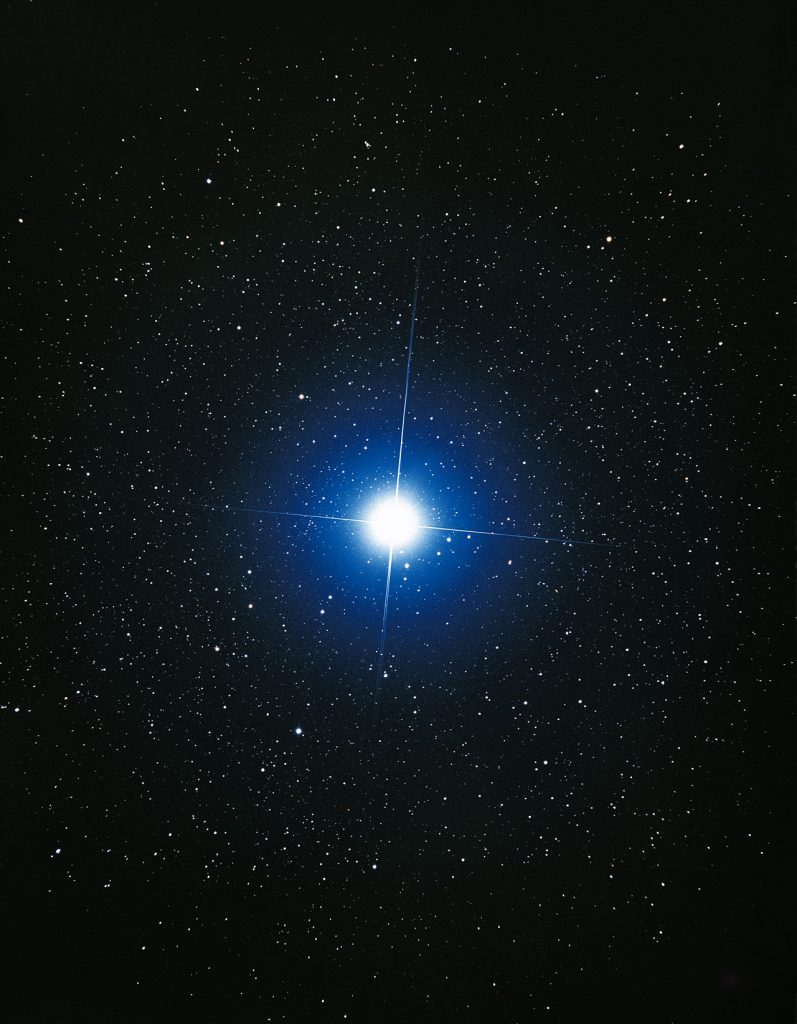
The ancient Egyptians linked their calendar to the arrival of Sirius in the pre-dawn sky because it signaled the onset of the Nile floods around the beginning of summer. That phenomenon also gave us the expression “Dog Days of Summer”. In China, Sirius is called Tiān Láng 天狼, aka “the Celestial Wolf”. Many First Nations cultures saw a dog’s shape in these stars and called Sirius the Moon Dog Star (Inuit), the Wolf Star (Pawnee), and the Coyote Star. On the next clear evening, have a look at our bright neighbour!
Public Astro-Themed Events
Every Monday evening, York University’s Allan I. Carswell Observatory runs an online star party – broadcasting views from four telescopes/cameras, answering viewer questions, and taking requests! Details are here. Their in-person Wednesday night viewing has been converted to online via the observatory YouTube channel.
On Wednesday afternoon, February 23 at 4:10 pm EST, University of Toronto will stream the annual, free to the public J Tuzo Wilson Lecture. Prof. Catherine Johnson from the Department of Earth, Ocean and Atmospheric Sciences, University of British Columbia and a Senior Scientist at the Planetary Science Institute, Tucson will speak on The Ins and Outs of Terrestrial Planets: A Magnetic Field Perspective. Details are here.
On Wednesday, February 23, 2022 from 7:30pm to 8:15pm, join RCIScience, the Allan I. Carswell Observatory, and Space Place Canada for a fun series of astronomy games and quizzes. Play alongside their expert contestants as they compete for bragging rights and you compete for prizes (and fun)! Live on YouTube. Details and the Eventbrite registration link for the free event are here.
My free, family-friendly Insider’s Guide to the Galaxy webcasts with Samantha Jewett of RASC National returns on Tuesday, March 1 at 3:30 pm EST, when we’ll once again welcome special guests: Isaac Murdock from Serpent River First Nation and Educator Jodie Williams. Together Isaac and Jodie will showcase how Indigenous knowledge systems can enhance current understandings of cosmology and astronomy. Through their new digital resource Lessons From Beyond, we’ll weave together multiple understandings of the universe and show how both Indigenous and Western knowledge systems can reflect, resonate with, and reinforce one another, affirming each other as valid, valuable, and vital. And – we’ll continue with our Messier Objects observing certificate program. You can find more details and the schedule of future sessions here.
Don’t forget to take advantage of the astronomy-themed YouTube videos posted by RASC Toronto Centre and RASC Canada.
Keep looking up, and enjoy the sky when you do. I love questions and requests. Send me some!